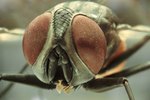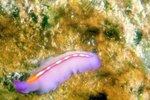
Peering at the world through giant eyeballs comprised of thousands of lenses, some bugs may seem to be "all eyes" as they alight on a nearby twig. These compound eyes are designed to detect the slightest movement by potential prey -- or predators -- and give bugs a nearly 360-degree view of their surroundings.
True Bugs
Insects with a non-retractable mouth tube known as a probiscus are known as true bugs. While all bugs are insects, not all insects are true bugs. The probiscus of a bug enables it to pierce and suck juices from plants, other insects or even animals. The most common big-eyed true bug include species belonging to the Geocoris species and is known commonly as "the big-eyed bug" because of its large, compound eyes. The bugs are found throughout the United States and are valued as predators of mites and insect pests that destroy lawns, gardens and crops.
Flying Insects
While not true bugs, many flying insects are commonly called "bugs" by the majority of people. Dragonfly eyes cover the majority of their heads with 30,000 lenses, yet they don't see details as well as a human. The praying mantis' large compound eyes are situated at the top corners of its triangular head, which can turn 180 degrees to look for the slightest movement of prey. The large compound eyes of butterflies and moths look like disco balls under magnification, with up to 12,000 facets.
Extra Eyes
Some insects not only have big eyes, but may have more than two. Whirligig beetles have two large compound eyes on top of their head and two more at the base of their throat. This enables the beetle to see both above and below water simultaneously as it swims through its watery habitat. Between their two large compound eyes found on each side of the head, wasps have three small eyes called ocelli that contain a single lens.
Eyes in Strange Places
A group of flies known as Diopsidae have eyes on stick-like projections that protrude from the side of their heads. The large bulbous eyes on the end of each stalk are reminiscent of a rosebud. Hairlike antennae sprout next to the eye and about halfway along the stalk in the stalk-eyed fly (Teleopsis dalmanni). The most wide-eyed members of the species seem to be the most attractive to members of the opposite sex and are also the most fertile.
References
- The University of Arizona College of Agriculture and Life Sciences: Big-Eyed Bugs Have Big Appetite for Pests [PDF]
- Arizona State University School of Life Sciences: True Bugs
- Arizona State University School of Life Sciences Ask an Entomologist: Do Insects Have Eyes?
- Hilton Pond: Whirligigs
- National Geographic: Stalk-Eyed Flies in Kenya
- Dragonfly Site: Fun Dragonfly Facts
- Eco In Your Hands: Butterfly Facts -- Butterfly Eyes
Photo Credits
-
Jupiterimages/liquidlibrary/Getty Images
Writer Bio
Indulging her passion for vacation vagary through the written word on a full-time basis since 2010, travel funster Jodi Thornton-O'Connell guides readers to the unexpected, quirky, and awe-inspiring.




